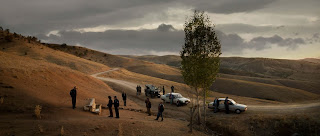Welcome to
the IFI’s April programme and a month long celebration of Carl Dreyer, one of
the 20th century’s unsung cinematic greats.
Carl Dreyer's Vampyr
This
month’s major retrospective of the best of Carl Dreyer’s films provides a
unique opportunity to experience the full range of this great director’s work
on the big screen, and to see for yourself why film critics claim him as one of
the masters of cinema. Two of his silent classics, The Passion of Joan of Arc and Master of the House, will be screened with live musical
accompaniment, giving a rare chance to experience silent film as it was
intended, mirroring the experience of audiences in the '20s. For a more
contemporary synthesis of sound and music, we will be showing Vampyr
again on May 18th with a live performance of his new score by Steven Severin,
acclaimed solo artist and founding member of Siouxsie and the Banshees. And for
those of you who want to find out more about Dreyer, don’t miss Peter Walsh’s
talk on April 18th at 2.30pm.
La Havre
Building on
our teen club, we’ve a film frenzy this month offering all those aged 15 to 18
a chance to explore a huge range of films from our programme at a very small price. For €3, teens can
choose from films like The Kid With a Bike, Le Havre, Into the Abyss, Marley
and many more. With this special offer which runs every day for the month of
April, from 1pm-6pm, young film fans can enjoy a different kind of cinema for
only €3 and get every fourth screening for FREE. Spread the word and tell any
budding cineastes you know – for more information please see www.ifi.ie/teen
To celebrate Ireland’s recent Oscar victory, we will be screening The Shore every Sunday throughout April at 13.10. The screenings are free and a great opportunity to see this beautiful story of hope and reconciliation on the big screen. Directed by Belfast’s Terry George, and produced with his daughter Oorlagh, The Shore stars Ciarán Hinds, Conleth Hill and Kerry Condon and should not be missed.
The Oscar-winning The Shore
Finally I
have to say a word of goodbye, as I will be leaving the IFI at the start of
April to take up the role of Director of IMMA. I wanted to take this
opportunity to thank the fantastic team at the IFI, the Board, and many, many
colleagues in the wider film community who have made my time here as Director
so rewarding and enjoyable! It has been an honour and a privilege to work at the
IFI. I truly believe it is one of Ireland’s most important, relevant and loved
cultural organisations, and I look forward to joining in the 20th anniversary
celebrations in September. But most of all I want to thank you, the audience,
for continuing to make the IFI what it is and making all our work here so
worthwhile.
Sarah
Glennie
Director
The Passion of Carl Dreyer retrospective continues at the IFI from 1st-29th April 2012. For more information on films and bookings, please contact our Box Office on 01-679 3477 or visit the season's page [here].
The Passion of Carl Dreyer retrospective continues at the IFI from 1st-29th April 2012. For more information on films and bookings, please contact our Box Office on 01-679 3477 or visit the season's page [here].
.jpg)


.jpg)

.jpg)
.jpg)
.jpg)







.jpg)














.jpg)